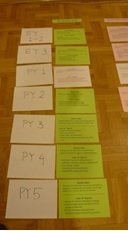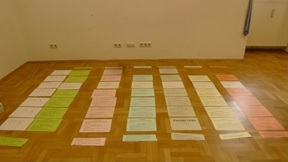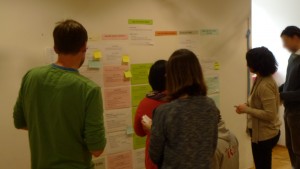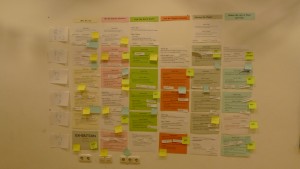This article is about the evaluation process of the programme of inquiry that is done collaboratively by the PYP teachers.
How do we evaluate our programme of inquiry? How do we improve the programme of inquiry as we reflect on the previous academic year? What tools do we use to evaluate? Who is involved in evaluating the programme of inquiry? When do we evaluate our programme of inquiry? Is it an on-going process?
It is common that PYP teachers reflect on and evaluate the school programme of inquiry at the end of an academic year so when they come back after the summer break, the programme of inquiry is ready to be used. However, we revisit the programme of inquiry before the school year ends to ensure that everything is covered both vertically and horizontally.
Evaluating the school programme of inquiry involves all PYP teachers; we plan and prepare the learning experiences collaboratively and at the end, we reflect and evaluate the programme of inquiry together.
Our school reflection process
Step 1 – Reflect on the current programme of inquiry
Each class teacher was given the primary years programme of inquiry rubric and used it to assess each grade level programme of inquiry that was done during the previous year. Although this was done at the beginning of the academic year using a checklist (central idea and lines of inquiry), adapted from Developing a transdisciplinary programme of inquiry (2012), this activity allowed teachers to identify the units that might be kept, changed or tweaked for the next academic year, based on each class teacher’s opinions and ideas.
Step 2 – Vertical evaluation (transdisciplinary theme)

 The school programme of inquiry from the current academic year was prepared and displayed on the floor. This activity allowed all teachers to assess the programme of inquiry vertically and horizontally. Each transdisciplinary theme was colour-coded which helped teachers to assess the units vertically. Teachers (class teachers and single-subject teachers) were paired up and were asked to look at one transdisciplinary theme.
The school programme of inquiry from the current academic year was prepared and displayed on the floor. This activity allowed all teachers to assess the programme of inquiry vertically and horizontally. Each transdisciplinary theme was colour-coded which helped teachers to assess the units vertically. Teachers (class teachers and single-subject teachers) were paired up and were asked to look at one transdisciplinary theme.
Each pair was given the descriptor of their assigned transdisciplinary theme and asked to place the description on each unit. This activity was to ensure that all aspects of the transdisciplinary theme are explored across grade levels.
After matching the description to the units, each pair shared their thinking. Teachers noticed that one aspect of the transdisciplinary theme could be covered by more than one unit and clarified whether or not the description matched the units.
Step 3 – Reflect on and evaluate the central idea and lines of inquiry
As teachers shared their thinking about the units, we started refining the central ideas and lines of inquiry. There were units that needed to be changed or shuffled based on how successfully they were taught, age-appropriate levels and how relevant and engaging the units were for the students.
Step 4 – Developing the school programme of inquiry for the coming academic year (horizontal evaluation)

Teachers using the programme of inquiry rubric to ensure the balance and articulation within the programme of inquiry
After brainstorming and sharing feedback on the units, we were almost ready to launch the school programme of inquiry for the next year. At this point, teachers were asked to look at the units horizontally. Class teachers were asked to place the concept cards on each unit. Listing the concepts (key concepts and related concepts) on the programme of inquiry helped to focus the direction of the inquiries. Single subject teachers were asked to look at the programme of inquiry and decide which units could be integrated easily with the subjects that they teach (music, physical education, arts, German, etc.), thereby helping teachers to plan and collaborate on the units and create meaningful connections across subjects.
Finally, class teachers decided the order the units would be taught, considering how the units would support one another and flow throughout the year. Class teachers looked at the school calendar to see the best time for having the units (field trips, learning experiences, school events, etc.) and also considered the subject focus order.
 The programme of inquiry for the next academic year is ready and class teachers now start thinking about and planning the first unit. When we return from summer break, a quick look will be done to make sure that all aspects of the transdisciplinary programme of inquiry are in place. Teachers revisit the programme of inquiry regularly when planning, working and reflecting on the units. Any changes will be added in the unit planner and eventually will help to refine and evaluate the programme of inquiry at the end of the academic year.
The programme of inquiry for the next academic year is ready and class teachers now start thinking about and planning the first unit. When we return from summer break, a quick look will be done to make sure that all aspects of the transdisciplinary programme of inquiry are in place. Teachers revisit the programme of inquiry regularly when planning, working and reflecting on the units. Any changes will be added in the unit planner and eventually will help to refine and evaluate the programme of inquiry at the end of the academic year.
—
Yuniarti Santosa is a PYP 2nd class teacher at International School Ruhr in Essen, Germany and from August 2015, she is starting her new role as a PYP Co-Coordinator who supports and works collaboratively with the PYP Coordinator. She has worked at PYP schools in Indonesia, Kazakhstan, Norway and Germany. She has been teaching for about 13 years with 10 years teaching experience in PYP schools. She is also an IB Online Facilitator.





Thanks for sharing this. We will review our PoI soon and your article gave me an idea how to do this.
Hi –
Thank you for sharing this description and the pictures, it’s very helpful!
You mentioned that you gave the teachers a rubric. Is that available in an IB doc somewhere?
Thanks,
-Karen